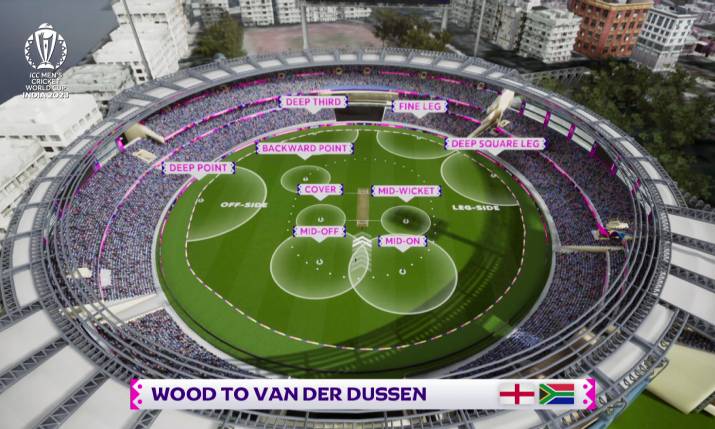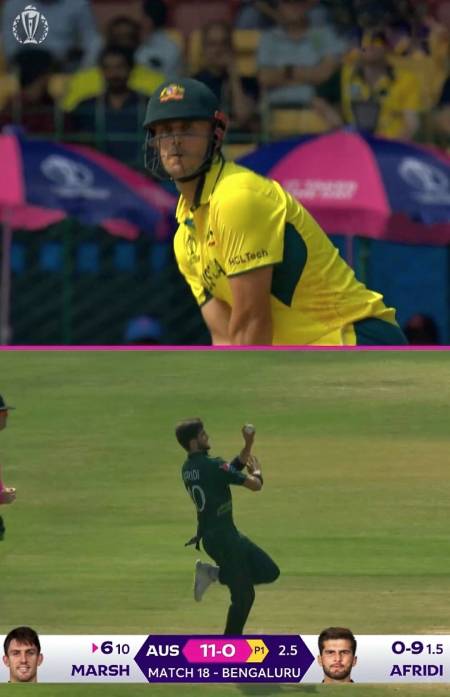Behind the ICC Men’s Cricket World Cup 2023 innovations with vertical video feed plus ball and player tracking

Field 360° from Quidich, which debuted at the 2022 ICC Men’s T20 World Cup, illustrates the real time spatial relationships between players on the field using dynamic visualisations and graphics for the ICC Men’s Cricket World Cup 2023
The ICC Men’s Cricket World Cup 2023 is in its penultimate week of a mammoth 46 day schedule culminating in the final on 19 November at the world’s largest cricket stadium – with a 132,000 capacity – located in Ahmedabad, Gujarat, India.
It is the first time since 2011 that the tournament has been hosted in the country where people practically worship cricket as a religion, and a number of innovations are being wrapped into the broadcast to make the coverage even better for fans.
The aim for the International Cricket Council’s (ICC) host broadcast by having all 48 One Day International (ODI) matches from India is to place this hardcore group of fans at the centre of the action. Alongside live coverage, a complete world feed service is available for licensees.

In a first for the sport, coverage of every match of the ICC Men’s Cricket World Cup 2023 is being produced in an additional vertical video for viewing on mobile phones
“From a planning perspective, with India being a big country and with games virtually every day at one of ten venues, the logistics were challenging,” says Ajesh Ramachandran, executive producer for ICC TV and senior manager for broadcast at the ICC.
“All matches are being produced and broadcast live on site.”
The tournament commenced on 5 October featuring 10 teams in a round-robin group competition. After the group stage’s 45 matches, the top four teams will advance to the semi-finals on 15 to 16 November.
For this, ICC TV is working with a number of individual service providers including NEP which is providing the bulk of the OB facilities and Disney Star for production services, pulling together all the logistics and crewing. Ramachandran adds that there are 150 crew at every game spanning production crew and engineering.
Each match has a minimum camera plan of 35 cameras including ultra motion, super slomo, Spidercam, drone and buggy cam.
“The spec is well rounded and consistent,” he says, “and it will remain the same even for the final.”
Hawk-Eye is providing DRS services including ball tracking and edge detection for officiating. Meanwhile AE Live is delivering the on-air graphics for the coverage, supplemented by in-depth cricket data analytics provided by Cricviz.
The format is in HD mainly because the biggest licensees – which in India is Star Sports Network – and the main market for the tournament are in the subcontinent where UHD is still a rarity.
Vertical feed first
In a first for the sport, coverage of every match is being produced in an additional vertical video for viewing on mobile phones. The vertical feed includes split-screens, designed to convey more context to the on-field action.
Ramachandran says: “The production is based out of Mumbai and is the only hub model we are using at this World Cup. We use feeds from both a set of dedicated vertical cameras, plus some world feed cameras. Some of the world feed cameras frame for the centre anyway so you can crop in real time for vertical and mix with the vertically oriented ones.”
Key features like ball tracking, player tracking and field plot are also tailored to fit the vertical format and includes bespoke commentary. In Mumbai a dedicated production team add match graphics.
ICC chief commercial officer, Anurag Dahiya added in a release: “It is an innovative approach to cricket coverage that will place fans at the centre of the action bringing them closer to the game than ever before and providing a world-class production to the biggest Cricket World Cup ever.”
Hawk-eye, working with the ICC, has expanded its graphics and data technology substantially since the Cricket World Cup 2019 where Hawk-Eye was giving the ICC ball tracking and lot of standard broadcast graphics, to today with ball pitch, speed and height, to off-bat tracking
Data hit for six
Live from the field data and analysis production has accelerated provision, Ramachandran says. “We’ve jumped substantially ahead from the Cricket World Cup 2019 where Hawk-Eye was giving us ball tracking and lot of standard broadcast graphics like ball pitch, speed and height. We’ve long been able to track everything from the bowler’s release onwards as long as the ball was within the pitch (the ball to bat field of play), but now Hawk-Eye, working with the ICC, has expanded that to off-bat tracking.”
As the name implies, this data tracking feature tracks the ball off the bat to wherever it ends up, and includes telemetry for bat speed, ball launch angle, launch velocity, and the apex height of the ball when travelling, which is particularly useful for analysing the height of catches and sixes.
“This innovation has a number of editorial uses such as helping the viewer understand why a catch was dropped,” explains Ramachandran. “We can also measure the distance thrown from the fielder back to the stumps.”
Another innovation is a virtual field model used to illustrate fielding positions and strategies based on technology from Mumbai-based developers, Quidich Innovation Labs.
Its Quidich Tracker (QT) is a proprietary player tracking and visualisation solution that uses optical tracking and computer vision to display an always-live field plot showing player placements, changes and player distances in real time.
Hawk-Eye’s data tracking feature for the ICC Men’s Cricket World Cup 2023 tracks the ball off the bat to wherever it ends up, and includes telemetry for bat speed, ball launch angle, launch velocity, and the apex height of the ball when travelling
An evolution of this is Field 360° from Quidich, which debuted at the 2022 ICC Men’s T20 World Cup. The technology illustrates the real time spatial relationships between players on the field using dynamic visualisations and graphics.
“We’re able to record fielding positions for every delivery and see how the field is spread out, what the distance between fielders is, where the gaps in the field lie. Over many years we’ve excluded analysis of these things because we didn’t have the technology and over the last few years we’ve taken great strides in explaining fielding strategy in a much better way,” notes Ramachandran.
The previously existing set up of viewing a cricket match offered little visual cues about the field placements and fielding changes. Broadcasters had no reliable visual to represent fielding strategy and changes in real time. As a result, viewers were clueless about the rationale for bowlers to bowl a particular line or length. They also did not get the batter’s viewpoint when they chose to play a shot in a specific direction.
In addition, the teams and coaches did not have any rich fielding data beyond manually logged basic information.
That has all changed with this solution. “We essentially gave them a set of problems to solve in broadcast and asked them to come up with ideas,” Ramachandran says of Quidich.
“Commentators like these gamified graphics because it helps them explain the effectiveness of fielding placements, and the challenges faced by batters in finding scoring opportunities.”
Data from the same system is used to provide a 3D graphical playback of a shot, such as a six, from the batter’s point of view. The technology was previously used in the Indian Premier League (IPL) and at the ICC World Test Championships where it was used more than 200 times during the final.
Quidich is also providing a drone camera for aerial views of all venues and surrounding geography, and a roving buggy cam for a ground level view.

“Commentators like these gamified graphics because it helps them explain the effectiveness of fielding placements, and the challenges faced by batters in finding scoring opportunities,” says Ajesh Ramachandran, executive producer for ICC TV and senior manager for broadcast at the ICC on the ICC Men’s Cricket World Cup 2023
Full rights holder service
Beyond live match coverage, ICC TV is producing non-live content, distributed to media rights partners via the ICC TV Content Delivery Service. This includes pre-match show, an innings interval programme, and a post-match wrap-up. ICC TV is also compiling daily player profiles, team features, match previews, venue spotlights, and behind-the-scenes content.
The ICC TV commentary team features three-time Men’s Cricket World Cup winner Ricky Ponting, alongside the captain who led England to their first Men’s Cricket World Cup title four years ago, Eoin Morgan and other ex-players including Ravi Shastri, Sunil Gavaskar, Nasser Hussein, Shaun Pollock, Lisa Sthalekar and Matthew Hayden.
The ten host venues include Ahmedabad (Narendra Modi Stadium), Bangalore (M. Chinnaswamy Stadium), Chennai (MA Chidambaram Stadium), Delhi (Arun Jaitley Stadium), Hyderabad (Rajiv Gandhi International Cricket Stadium), Kolkata (Eden Gardens), Dharamsala (HPCA Stadium), Pune (MCA International Stadium) and Lucknow (BRSABVE Cricket Stadium).
In addition to the English world feed, Star Sports will also broadcast the tournament in India in Hindi, Tamil, Telugu and Kanada. Digital platform Disney+ Hotstar will host each match live.
Sky Sports holds rights in the UK where it is coverage on Sky Sports Main Event and digitally via the SkyGo and the Sky Sports App. WillowTV is the channel to watch for fans in the US while coverage will also be available via the ESPN+ app. SuperSport and its app will broadcast the action in South Africa and to the 52 Sub-Saharan Africa territories. Fox Sports and Kayo is the home of Australian coverage; Sky Sport NZ covers New Zealand and in the UAE and the entire MENA region, all matches are being streamed on Starzplay.
ICC Men’s Cricket World Cup 2023 continues until 19 November.

